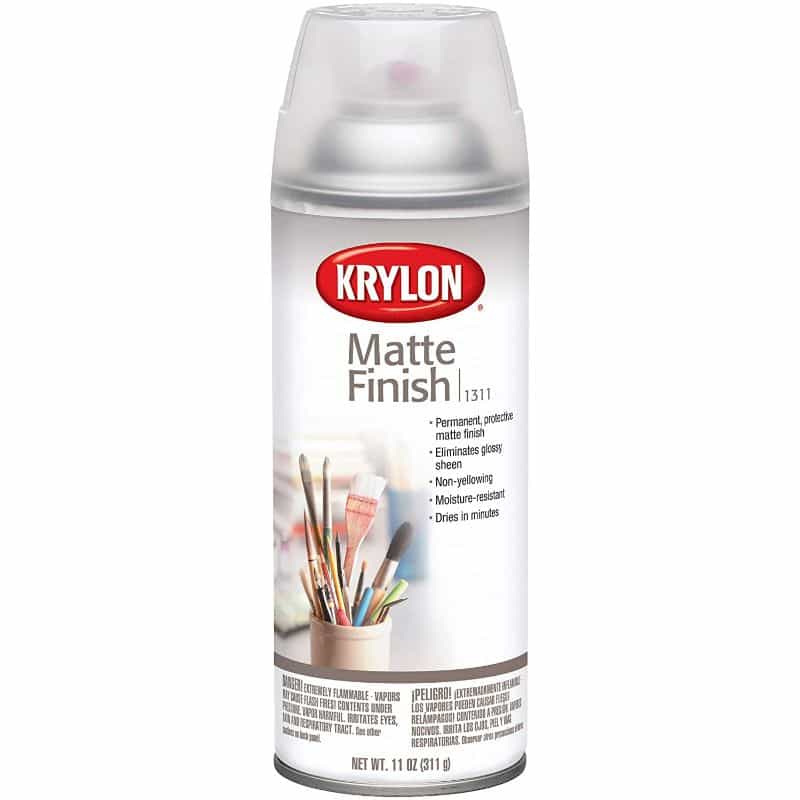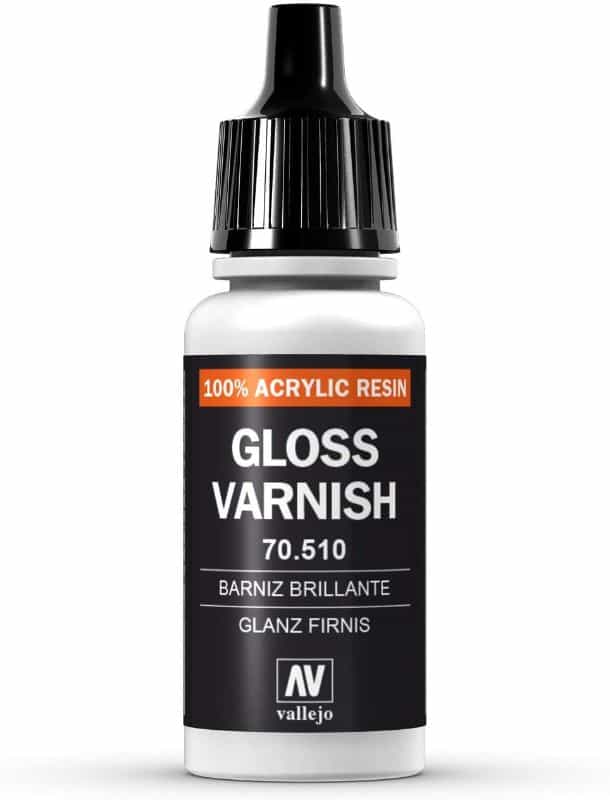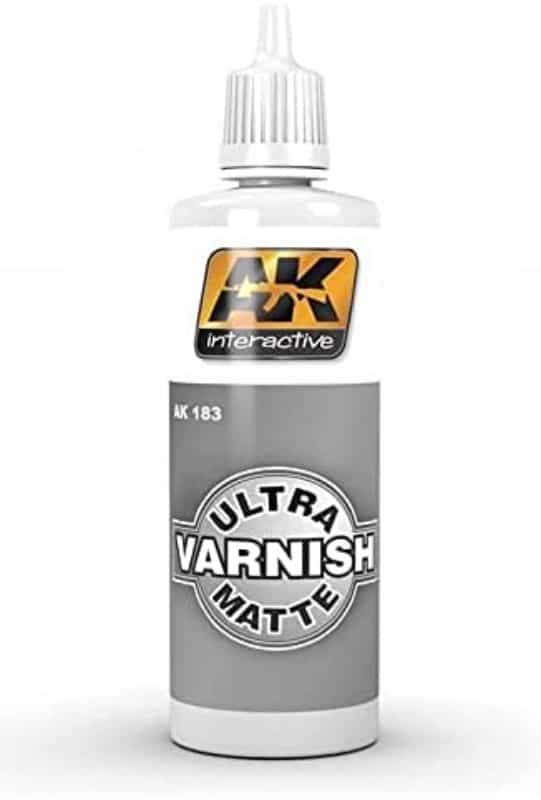What’s the difference between a matte and gloss varnish for miniatures? Simply put, a gloss varnish creates a reflective, shiny finish on your models. And, a matte varnish produces a non-reflective, dull or flat finish coat on your painted miniatures. But, there are more differences you should know in what varnish type to use, including the final painted appearances, as well as functional aspects in your miniature paint jobs.
In this article, I show you the key differences in a gloss versus matte varnish, including best uses and practice, and tips for which to use in your miniature painting projects. I will also highlight a few popular varnishes that I’ve used for my work.

Summary: Gloss Versus Matte Varnishes for Miniatures, Models, and Other Painted Surfaces
A gloss varnish will give your miniature or scale model a glossy and shiny finish. A matte varnish gives you a less shiny, dull or flat look that is more appropriate for tabletop gaming miniatures and models of military vehicles, models of buildings, etc.
For miniature painting, a matte varnish is the better choice for the final coat because it protects your models, while reducing undesired light reflections that can distort contrast and color saturation. A matte varnish can also help you photograph your models by reducing harsh, unwanted specular highlights from appearing all over your painted model.
RELATED: RECOMMENDED MATTE VARNISHES FOR PAINTED MINIATURES AND WARGAMING MODELS
Recommended Gloss and Matte Varnishes for Miniatures
| Image | Varnish | Best Features |
|---|---|---|
 | Testors Dullcote Enamel Finishing Coat |
|
 | Krylon Matte Finish Aerosol Spray |
|
 | Vallejo Acrylic Gloss Varnish |
|
 | Vallejo Matt Model Color Varnish |
|
 | AK Interactive Ultra Matte Varnish |
|
Pros and Cons of Matte and Gloss Varnishes
Gloss Varnishes
Pros
- Adds a reflective shine to the miniature.
- For models of military vehicles, buildings, etc., this is the best varnish to use
- The gloss varnish can create a very realistic effect for something that’s not metallic
- Easier to apply than matte varnishes (e.g., no risk for fogging or frosting)
- Great for mimicking wet surfaces or slime effects, such as putting a gleam on the surface of eyes and gaping mouths
Cons
- Not the best varnish for miniatures of characters, especially if that character has exposed skin, flesh, clothing, or other non-reflective surfaces
- Gloss varnishes often produce a “fake” or “cartoony” look on miniatures, if applied over the entire model
- Some thick coats of gloss varnish will have a subtle blue or yellow hue (i.e., keep varnish layers thin)
Matte Varnishes
Pros
- Matte varnishes are great creating realism in scale models and miniatures
- Matte varnishes help with hiding subtle blending errors or flaws on the surface of a miniature, e.g., creates soft blurring effect in layered transitions
- Choosing a Matte varnish when painting buildings or military vehicles can make those surfaces look worn and more dynamic
- A matte finish makes photographing your models easier
Cons
- The matte finish can leave a very dull, flat appearance on your miniature, so it’s best not to over apply it
- Aerosol (spray can) applied matte varnishes can frost or fog when used in poor ambient conditions with high humidity
- Brush on matte varnish is not ideal, and is best applied with a spray application, e.g., airbrush or aerosol
- May be less durable than gloss varnishes
Other Notable Differences Between a Matte or Gloss Varnish for Miniatures
Matte Varnishes Can Smooth Out Paint Layer Transitions
The benefits of using a matte varnish are that it can be used to diffuse some of the light that shines on the miniature in order to show softer details or tonal values. This also gives a smoother appearance of the different colors on a model, which helps “post-blending” of layered transitions.
For example, if you didn’t do a perfect job glazing or blending two layers of acrylic paint color together, a matte finish may help push that extra blur effect for you.
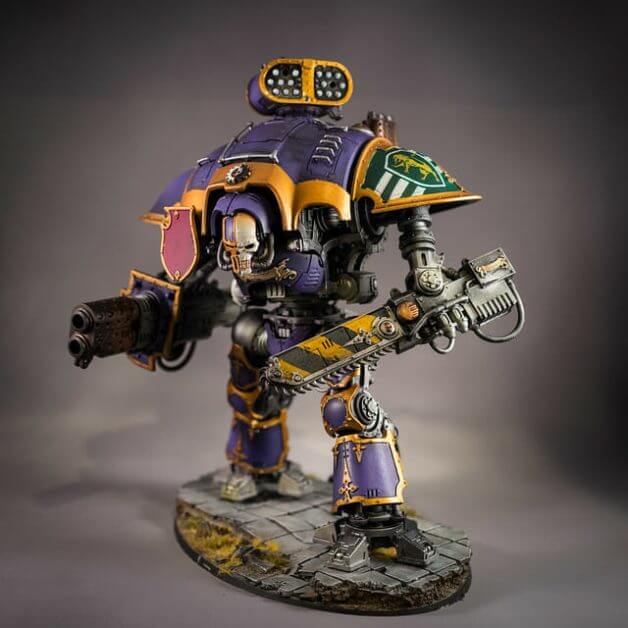
Of course, the disadvantages of the matte varnish finish are that you’re at risk of creating a foggy or frosted finish. This usually happens when you’re applying matte varnish with a spray can under bad ambient conditions. For more about how to avoid (and fix) fogging varnish on your miniatures, check out this article.
Another issue that may arise is that a matte varnish if applied too thickly will create a muted texture that can dull out your colors, reducing their saturation. Shiny metallics may also lose their reflective, sheen. You can fix these dull effects, by subtly repainting parts of those surfaces with the same paint on top. Or, you can apply a thin coat of gloss varnish on top and re-apply the matte varnish (but, I don’t do this often, as thick varnish layers also makes details harder to see).
Gloss Varnishes Emphasizes 3D Shape and Enhances Color Vibrancy
A gloss varnish has an advantage on miniatures in that is can create very reflective, shiny finishes that emphasizes a miniature’s form and shape. Models tend to look bigger, and the acrylic painting takes on a large form factor. A gloss coat will make an acrylic painted miniature stand out.
I will also say that a gloss varnish will also make paint colors appear bolder, more vibrant than most matte varnishes when applied on small surface areas of a miniature.

Use Gloss Varnishes for Special Effects
Gloss varnishes are also great for creating special effects that involve a wet-look, or slimy, slippery surfaces. Use your imagination for how best to apply a gloss varnish. I will say that applying a gloss varnish on small areas of a matte finished miniature, will make those glossy areas stand out even more.
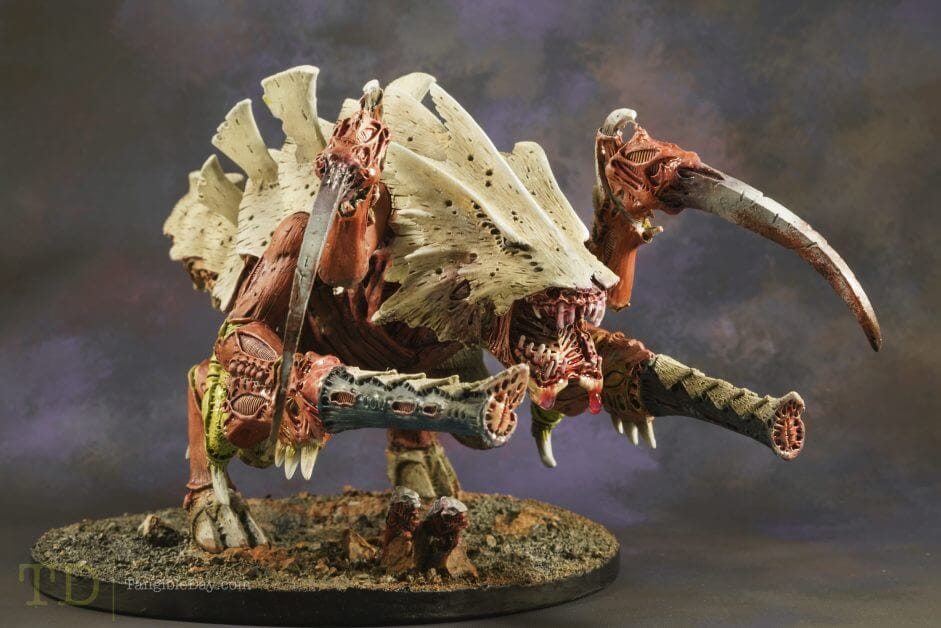
Achieve “Texture Contrast” with Juxtaposed Gloss and Matte Varnish Applications
The contrast of reflective vs. non-reflective surfaces is an under-used technique in miniature painting. I try to do this whenever I can. For example, applying gloss over eyeballs when the rest of the face is grimy and matte, makes those eyes really stand out. It adds personality and interest to a painted miniature, whereas a paint job (albeit a great one) may not pull as the emphasis to an area of a model.
5 Useful Tips for Applying Varnish on Your Models
1. Apply Varnishes in Multiple Thin Layers
The best way to apply any hobby varnish is by using multiple thin layers, instead of a single thick coat. This will not only help to make the surface more durable, but avoid coating your models in thick layers of varnish that can obscure details and reduce color vibrancy and contrast that you worked hard to achieve.
2. Use Hobby Model Varnishes
Always use a varnish that is specifically designed for finishing miniatures or scale models. Lacquer based clear-coat aerosol sprays, especially matte or satin finishes, can work in some cases, but may be unsuitable for small scale models. Additionally, some varnishes dry with a warm colored hue, e.g., floor varnishes, or certain varnishes for furniture, and aren’t going to produce desirable results with your painted miniatures.
3. Test Your Varnish Before Applying it to Your Miniatures
If you’re unsure of a varnish, then test it on an area of your model that isn’t easily visible. Or, test the varnish on a different surface altogether. For example, you can try painting rocks like I do for practicing acrylic techniques without ruining my miniatures. I also use rocks to demonstrate paint blending methods and test out new art products.
4. Mix Your Varnish Solutions
For matte varnishes on miniatures, it is best practice to shake the bottle well. I found that by shaking the bottle for 3 to 5 seconds when I was ready to use it, the varnish resulted in a more reliably matte finish. I use a motorized hobby paint bottle mixer. Thin layered applications will reduce any bubbles when you apply it with a brush.
5. Spray Varnish Properly for Best Results
For using an airbrush, it is best practice to let your miniatures dry between sprayed coats. This reduces the chance of pooling the varnish and creating those pesky “spider webs” of liquid over your model.
READ MORE: 10 GREAT SPRAY BOOTHS FOR TABLETOP GAMING MINIATURES AND SCALE MODELS
I also find that it is best to do my spraying or brushing application of varnish in stages when finishing large models. I apply a single coat on sections, letting each dry before applying more. By doing this, I get the most even and smoothest finish when using your brush/airbrush.
Best Varnishes for Painted Miniatures and Models
There are many varnishes on the market. I highlight and compare 5 popular hobby varnishes that I use for sealing miniatures after painting. These brief overviews are in no particular order. Each varnish has its own pros and cons.
- Testors Dullcote Enamel Finishing Coat
- Krylon Matte Finish Aerosol Spray
- Vallejo Acrylic Gloss Varnish
- Vallejo Matt Model Color Varnish
- AK Interactive Ultra Matte Varnish
1. Testors Dullcote Enamel Finishing Coat
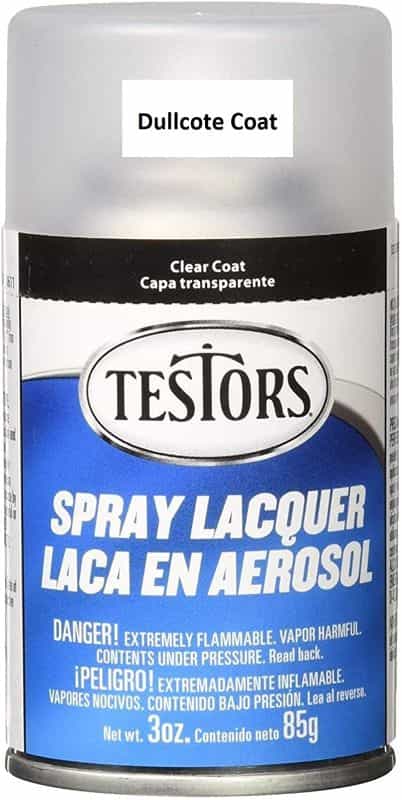
This is my favorite matte varnish for almost any miniature I paint. Here’s my in-depth user review of this varnish and how to use it. Testors Dullcote is an enamel-based lacquer, which means it uses a volatile solvent (e.g., xylene) in its aerosol formula. It is very fast drying, durable, and provides an excellent matte finish with all the benefits discussed above.
Testors Dullcote is best applied when you are completely finished with painting a miniature. It can often hide any subtle brush strokes in your paint application and help you create a smooth, non-reflective professional finish. Simply put, I love this stuff.
Now it’s not all roses and rainbows. Testors Dullcote produces a nasty smelling vapor that sticks around if you’re spraying in an indoor room without good ventilation. Make sure you open a window or have a ventilated spray booth.
Testors Dullcote is also an aerosol spray that is vulnerable to user-error. For best results, always make sure you shake the can vigorously before use, and never spray in high relative humidity (>50%) or cold temperature. You can read more about how to solve issues with frosting matte varnish.
It is best used for models that have already been fully painted . This allows the varnish to level out any bumpy spots in your paint job and hide up any brush marks you might have left behind. It will also give a nice, smooth, even clear coat on top of your model or miniature once it is sealed with this varnish.
Pros:
- It dries fast and is easy to apply
- After it dries, the surface becomes very smooth and shiny
- This varnish can be used on plastic models, resins or metal miniatures in any scale (it’s not intended for use with precious metals)
Cons:
- It is an aerosol spray that has foul, harmful fumes
- There is risk for fogging up or frosting, if sprayed in poor ambient conditions, e.g., high humidity or cold temperatures
Krylon Matte Finish Aerosol Spray is easy to use and leaves a matte, non-reflective finish that offers complete protection for art and model surfaces. I’ve used it to apply a quick clear coat over entire miniatures, especially larger models. It does have the tendency to spray in a wide pattern, so make sure to hold the nozzle back from the model or test the spray first.
For painted miniatures, Krylon Matte Spray is a great varnish to use if you want the surface to be protected from normal day to day handling and gameplay. Krylon sealant dries relatively quickly, but you can speed up the process with a hair dryer (something you can do with any varnish, actually).
This varnish will not change the color of your base coat so you can use it on painted miniatures without worrying about colors turning out weird. Acrylic paintings with a good coat of Krylon clear coat will also have improved durability. And, there’s a reason this is a popular varnish for acrylic paint on clay and can serve as a clear coat for chalk paint.
I would note that this does not have a very matte finish. It is more of a satin finish for your models. But, overall, it is much better than no varnish at all, and it does help even out surface reflections for a nicer looking paint job.
Pros:
- Easy to use
- Wide spray pattern covers surfaces, quickly
- Leaves an even mostly matte, durable non-reflective finish that offers protection for your models
- Inexpensive
Cons:
- Aerosol spray with risk for fogging if sprayed in poor environmental conditions of high humidity or cold air
- Not really “matte” (has a satin finish)
Vallejo Gloss Varnish is an acrylic-based gloss varnish that you can thin with water. It comes in a convenient dropper bottle making it easy to dispense the varnish into an airbrush paint cup or onto a palette. From my experience, Vallejo dropper bottles are also easy to travel with because there is no risk for spillage from caps popping open. It’s easy to throw in my gaming travel bag or my favorite portable painting station.
Whether you are looking to make the surface shine or create a wet-looking special effect, this acrylic varnish has been perfect for my smaller projects. For example, as mentioned above, one use I like applying with gloss varnishes is to juxtapose a reflective surface against a matte, non-reflective surface (contrast through texture). Vallejo gloss is great for this technique and effect.
Finally, I’ll note that Vallejo Gloss Varnish does protect against scratches and light abrasions, as well as UV rays shining onto the miniature from bright lights (such as direct sunlight). If you’re looking to protect your models, you may want to use this underneath a matte spray varnish, such as Testors Dullcote (see #1).
Pros:
- Water soluble for thinning
- Can be applied with a brush or sprayed directly on with an airbrush
- Protects against some light scratches and abrasions
- Good for wet, slime special effects
Cons:
- Brushing may pick up dirt, dust, or hair that might have been on the model before it was painted so make sure you clean off your brushes thoroughly after use
- Can sometimes appear slightly cloudy, if it is applied too thick on the surface
- Reflections on a miniature’s glossy surface will make photography more difficult
Vallejo Matte Varnish is a water-based, fast drying varnish with a matte, non-reflective finish. I’ve had good experience using it to protect a model after a paint job. Unlike an aerosol matte spray, like Testors Dullcote or Krylon Matte Spray, a water based matte varnish like Vallejo varnishes are at much lower risk for fogging or frosting. However, you do need to make sure you shake and mix the bottle well before use.
You can use this with a brush on application or spray it onto your model through an airbrush. Just make sure you thin the varnish down so it doesn’t clog your airbrush. For thinning the varnish, you can use water or Vallejo airbrush thinner. Both work great. Of course, for best results with this or any other varnish, apply it in multiple thin layers and work in sections for larger models.
As with other Vallejo mediums in dropper bottles (like the gloss varnish in #3), this matte varnish is easy to take with you wherever you go, or store on your hobby painting desk.
Pros:
- Gives nice matte finish to the miniature
- Is water based, non-aerosol, and so has lower risk of fogging or frosting
- Works great on all kinds of miniatures, large and small
- Easy and safe to apply with a regular brush or airbrush (e.g., spraying it is better)
Cons:
- Due to it being a matte varnish, this can reduce color saturation and richness if layered on too thickly
- As with any brush on varnish, it is easier to pick up dirt, dust, or hair and leave brush marks
- May be expensive compared with other water-soluble, artist-grade matte varnishes
AK Interactive Ultra Matte Varnish is a little more expensive than a standard matte varnish, but the results are well worth it. The finish is “ultra” matte, almost to the point of dulling or flattening out your paint job. It does reduce contrast a bit, too, so you may want to test it out on another surface first before applying it to your painted miniature.
From a professional standpoint, the results of your miniature paint job will depend on how well you even out reflective surfaces for a cohesive appearance in color and contrast. A user tip I’ve read, but haven’t tried yet, is to use a thin layer of gloss over areas that you coated with AK Ultra Matte to remove unwanted dullness. In my opinion, this defeats the purpose. Instead, I would recommend using an airbrush to apply this varnish, if you have one. Here are the airbrushes I’ve reviewed for this and other miniature painting purposes.
In general, AK Ultra Matte Varnish is especially useful for varnishing and protecting larger models, such as tanks or vehicles, as you can use a single coat (yeah, it’s that effective). Note that I do use a soft bristled brush for applying this varnish on small models, e.g, most infantry or trooper sized models, such as 40k Space Marines.
Is AK Interactive Ultra Matte Varnish better than Vallejo Matte Varnish? It’s more expensive, and needs to be applied in thinner layers to avoid dulling your paint job. I suppose it depends on how much of a “matte”, non-reflective effect you want. Sometimes too much of a matt coating can make your colorful paint job look dull. You going to have to experiment!
Pros:
- Any matte varnish, including AK Interactive’s, will achieve a more realistic finish on miniatures or models, if applied appropriately, and recommended for modellers working with dioramas
- The ultra matte finish is wonderful for taking great photographs of your painted miniatures
- Super matte finish creates a perceptibly smoother finish to your models
- Easy to apply in all kinds of environmental conditions
- Works fine with a brush or airbrush (i.e., you can thin with water)
Cons:
- Can dull colors and reduce contrast, if overused
- Requires constant bottle shaking to ensure the varnish is mixed well before use
- Will dry quickly and could leave unwanted texture with a brush on application
- It is more expensive than other matte varnishes on a per volume basis
Conclusion
If you’re looking for examples of my miniature paintings that I varnished, you can check out my gallery. When it comes to miniature painting, a matte or a gloss clear spray paint sealer will protect your hard work.
For the final coat, I generally find that a matte varnish is the better choice (versus gloss) because it protects your models, while reducing undesired light reflections that can distort contrast and color saturation. A matte varnish can also help you photograph your models by reducing harsh, unwanted specular highlights from appearing all over your paint.
On the other hand, a gloss varnish is useful for special effects, e.g., recreating wet or shiny surfaces, enhancing the durability of your final clear coat, and creating texture contrast against a less reflective surface. Overall, you’ll find having both types of varnishes in your miniature painting toolbox useful.
Which do you prefer for most paint jobs? Do you use any matte or gloss varnishes that you like? Let me know below!



Tangible Day on YouTube (Miniatures and More!)

